
Bloomington is a city in and the county seat of McLean County, Illinois, United States. It is adjacent to the town of Normal, and is the more populous of the two principal municipalities of the Bloomington–Normal metropolitan area. Bloomington is 135 miles (217 km) southwest of Chicago and 162 miles (261 km) northeast of St. Louis. The 2020 census showed the city had a population of 78,680, making it the 13th-most populated city in Illinois and the fifth-most populous outside the Chicago Metropolitan Area. Combined with Normal, the twin cities have a population of roughly 130,000. The Bloomington area is home to Illinois Wesleyan University and Illinois State University. It also serves as the headquarters for State Farm Insurance and Country Financial.
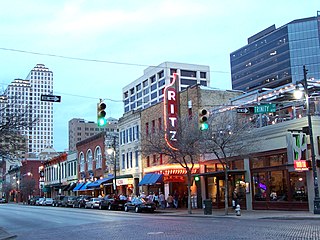
Sixth Street is a historic street and entertainment district in Austin, Texas, located within the city's urban core in downtown Austin. Sixth Street was formerly named Pecan Street under Austin's older naming convention, which had east–west streets named after trees and north–south streets named after Texas rivers.

The East Grove Street District is a residential historic district located on the 400 through 700 blocks of East Grove Street in Bloomington, Illinois. The district includes 43 houses and apartment buildings, 25 of which are considered contributing buildings. The houses in the district were built between 1855 and 1915 for many of Bloomington's upper middle class residents. Due to a building boom between 1880 and 1900, the then-popular Queen Anne style is the most prevalent in the district. Other popular architectural styles in the district include Greek Revival homes from the 1850s, Italianate homes built between 1860 and 1880, and Arts and Crafts homes built in the 1900s.

Downtown Grand Forks is the original commercial center of Grand Forks, North Dakota, United States. Located on the western bank of the Red River of the North, the downtown neighborhood is situated near the fork of the Red River and the Red Lake River. While downtown is no longer the dominant commercial area of the Greater Grand Forks community, it remains the historic center of Grand Forks. An 80.4-acre (32.5 ha) portion was listed on the National Register of Historic Places in 2005, as Downtown Grand Forks Historic District. Today, downtown Grand Forks is home to many offices, stores, restaurants, and bars.
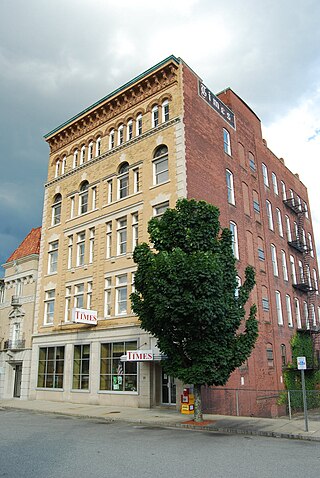
The Downtown Pawtucket Historic District encompasses a major portion of the central business district of Pawtucket, Rhode Island. The city's downtown was developed primarily between 1871 and 1930, covering the period when it grew to become the second-largest city in the state. The district is irregularly shaped, including properties on Montgomery Street south of Manchester, and properties on Exchange, North Union, and Summer streets between Broad and High Streets, as well as a few properties on Main Street and Maple Street east of Park Place. It includes 50 buildings on 14 acres (5.7 ha), built in a cross-section of architectural styles from the late 18th century to the mid-20th century, although the main exterior construction material is brick. Most of the buildings are commercial in use, although there are three houses and a church included in the area.

The Provo Downtown Historic District is a 25-acre (10 ha) historic area located in Provo, Utah, United States. It is listed on the National Register of Historic Places.

The Bridgeport Downtown North Historic District encompasses a portion of the commercial downtown of Bridgeport, Connecticut. It isroughly bounded on the north by Congress Street, the east by Water and Middle Streets, the south by Fairfield Avenue, and the west by Lyon Terrace, roughly the northeastern quadrant of the downtown area. It is one of two large clusters of historically significant commercial and civic buildings encapsulating the city's growth as an urban industrial and regional government center. It was listed on the National Register of Historic Places in 1987.

The Downtown Concord Historic District encompasses most of the commercial heart of downtown Concord, New Hampshire, United States. Incorporated in 1734, Concord became the state capital in 1808 and the seat of Merrimack County in 1823. Economic growth followed, due in part to these government institutions and also to the rise of industry along the Merrimack River, which flows through the city east of the downtown area, and the arrival in the 1840s of the railroad. The New Hampshire State House was built in 1819 south of the traditional center of the city, and the commercial heart of the city began to take shape along the First New Hampshire Turnpike south of the State House. The district was listed on the National Register of Historic Places in 2000.

The Paragould Downtown Commercial Historic District encompasses the historic central business district of Paragould, Arkansas. The city was organized in 1882 around the intersection of two railroad lines, which lies in the southwestern portion of this district. The main axes of the district are Court and Pruett Streets, extending along Court from 3½ Street to 3rd Avenue, and along Court from King's Highway to Highland Street, with properties also on adjacent streets. Prominent in the district are the 1888 Greene County Courthouse, built during the city's first major growth spurt. Most of the district's buildings are one and two stories in height, and of masonry construction. The National Bank of Commerce Building at 200 S. Pruett is a notable example of limestone construction, and of Classical Revival styling found in some of the buildings put up during the city's second major growth period in the 1920s.
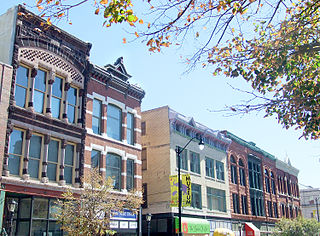
The Central Springfield Historic District is a 12-acre (4.9 ha) historic district in downtown Springfield. The district encompasses Springfield's oldest commercial district and is centered on the Old State Capitol. While the area was platted in 1822, only two buildings in the district predate the 1850s: the Old State Capitol and the Lincoln-Herndon Law Offices, both built in 1837. The majority of the district's buildings were constructed during Springfield's population boom in the 1860s and its subsequent growth in the latter half of the 19th century. These buildings included hotels, drug stores, groceries, clothing stores, and dry goods stores; some of the stores built in this period are still in operation. The businesses are also significant examples of 19th-century brick commercial architecture, including the Romanesque Pierick-Sommer Building and several works by prominent Springfield architects Helmle & Helmle.

The Downtown East St. Louis Historic District is a historic commercial district in downtown East St. Louis, Illinois. The district includes 35 buildings, 25 of which are contributing buildings, along Collinsville Avenue, Missouri Avenue, and St. Louis Avenue; all but one of the buildings was historically used for commercial purposes. While development in the area dates back to the late 19th century, the first of the extant buildings in the district were built around 1900 after a tornado devastated the area in 1896. By 1910, the area had become a prosperous commercial district with stores, offices, and entertainment venues; surviving buildings from this period include the Murphy Building and the Cahokia Building. Another large building boom took place in the 1920s, adding buildings such as the Spivey Building, the city's only skyscraper; the Union Trust Bank Company Building, the largest bank in the city; the Grossman Building; and the Majestic Theatre. The new buildings both coincided with a population and economic expansion in the city and allowed it to forge an architectural identity distinct from neighboring St. Louis.

The West Hill Historic District in Muscatine, Iowa is a historic district that was listed on the National Register of Historic Places in 2008. At that time, it included 258 contributing buildings, two contributing objects, two contributing sites, and 67 non-contributing buildings. The city of Muscatine was established as Bloomington in 1836. The original town was built on land that is generally flat along the Mississippi River. Residential areas were built on the surrounding hills, while commercial and industrial interests developed on the flatter land near the river. The West Hill Historic District is immediately to the west of the Downtown Commercial Historic District. The period of significance for West Hill begins in 1839 and ends in 1958. Some of the largest and oldest historic houses in Muscatine are located here, but it also includes smaller residences of the working and middle class. By 1915, 180 of the historic houses had been built. The rest were built from 1916 to 1958. Another eight houses were built between 1960 and 1995. A majority of the houses (80%) are two stories in height. Frame construction (70%) outnumbers brick construction (30%). The architectural styles that were prominent across the country are also found here and were built at the time they were popular.

The Downtown Commercial Historic District encompasses most of the central business district of Burlington, Iowa, United States. It was listed on the National Register of Historic Places in 2015. The historic district includes 65 properties that were part of a 2012 to 2013 survey of the area. It also includes as contributing properties the buildings in the West Jefferson Street Historic District and three buildings in the Manufacturing and Wholesale Historic District that were previously listed on the National Register. All total there are 122 resources within the district, which includes 108 contributing and 14 non-contributing properties.
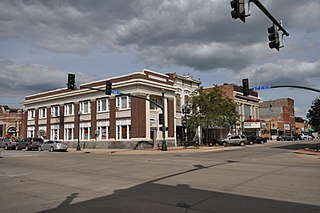
The Cherokee Commercial Historic District is a nationally recognized historic district located in Cherokee, Iowa, United States. It was listed on the National Register of Historic Places in 2005. At the time of its nomination it contained 70 resources, which included 50 contributing buildings and 20 non-contributing buildings. The historic district covers most of the city's central business district. Most of the buildings are two and three stories tall, and built of brick. There are two frame buildings from the city's earliest years. Cherokee is somewhat unusual in that it did not have a devastating fire in its history, therefore the downtown area was able to grow incrementally. Unlike many county seats, it does not have a focal point such as a centrally located courthouse square. The Cherokee County Courthouse was built on a hill to the west of the downtown area.

The Osage Commercial Historic District is a nationally recognized historic district located in Osage, Iowa, United States. It was listed on the National Register of Historic Places in 2002. At the time of its nomination it contained 50 resources, which included 46 contributing buildings, one contributing structure, and three non-contributing buildings. The historic district covers most of the city's central business district.

The City Hall Park Historic District encompasses one of the central economic, civic, and public spaces of the city of Burlington, Vermont. Centered on City Hall Park, the area's architecture encapsulates the city's development from a frontier town to an urban commercial center. The district was listed on the National Register of Historic Places in 1983.

The Downtown Essex Junction Commercial Historic District encompasses the historically railroad-dominated portion of downtown Essex Junction, Vermont. Aligned along the south side of Railroad Avenue and adjacent portions of Main Street, the area underwent most of its development between 1900 and 1940, when Essex Junction served as a major regional railroad hub. The district was listed on the National Register of Historic Places in 2004.
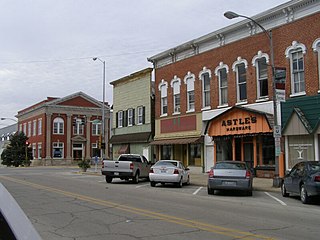
The Downtown Momence Historic District is a national historic district which encompasses the commercial core of downtown Momence, Illinois. The district includes 49 contributing buildings, all but two of which are commercial buildings; the remaining two are residential. While the oldest building in the district dates to 1849, significant development in downtown Momence did not begin until the Chicago, Danville and Vincennes Railroad reached the city in 1871. Roughly one-third of the district's buildings, primarily retail stores, were built between 1871 and 1900. Most of the remaining buildings were built between 1900 and 1930; these were more diverse and included banks, entertainment and recreational facilities, and automobile-related businesses toward the end of the period. The architectural styles seen in the district are representative of American commercial architectural trends of the late 19th and early 20th centuries; the majority of the buildings have Italianate designs, though examples of Greek Revival, Classical Revival, and Romanesque Revival architecture can also be found in the district.

The City Hall-Monument District encompasses the city hall complex and central municipal park of New Britain, Connecticut. A prominent part of the city's downtown business district, the city hall is an architecturally distinguished former hotel, while the park includes a substantial Beaux Arts Civil War memorial. The district was listed on the National Register of Historic Places in 1973.

Le Mars Downtown Commercial Historic District is a nationally recognized historic district located in Le Mars, Iowa, United States. It was listed on the National Register of Historic Places in 2012. At the time of its nomination the district consisted of 96 resources, including 73 contributing buildings and 23 non-contributing buildings.





















